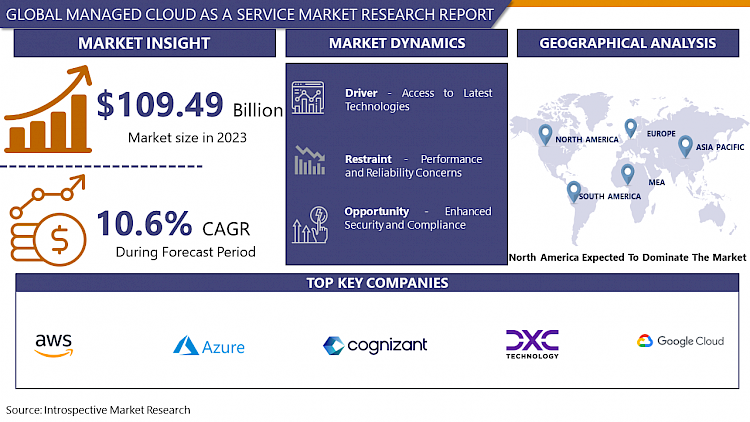Managed Cloud as a Service Market Synopsis
Managed Cloud as a Service Market Size Was Valued at USD 109.49 Billion in 2023, and is Projected to Reach USD 271.14 Billion by 2032, Growing at a CAGR of 10.6 % From 2024-2032.
Managed Cloud as a Service refers to a model where a third-party provider offers comprehensive management and support services for cloud-based infrastructure, applications, and platforms. In this model, the service provider takes responsibility for tasks such as provisioning, monitoring, maintenance, security, and optimization of cloud resources on behalf of the client. Managed Cloud as a Service allows organizations to leverage the benefits of cloud computing while offloading the operational burden and technical complexity associated with managing cloud environments.
- Managed Cloud as a Service providers manage cloud infrastructure, including servers, storage, networking, and virtualization resources, allowing organizations to offload daily operational tasks. They offer data management services, including backup, replication, and disaster recovery solutions, to protect critical data assets and meet regulatory requirements. Managed Cloud as a Service also provides application hosting and deployment services, including virtual machines, containers, and serverless platforms. Managed platform services offer higher-level capabilities for application development, integration, and deployment, allowing organizations to focus on building and running their applications without managing underlying infrastructure.
- Managed Cloud as a Service provider also offers security services to protect cloud environments against cybersecurity threats and ensure compliance with industry regulations. They optimize cloud environments for performance, scalability, and cost efficiency using automation, analytics, and best practices. They provide monitoring, support, and troubleshooting services to ensure cloud environment availability and performance. Lastly, Managed Cloud as a Service providers help organizations optimize cloud costs by providing visibility into usage, identifying cost-saving opportunities, and implementing cost management strategies.
- Managed Cloud as a Service provider manage cloud infrastructure, providing data management, application hosting, and deployment services. They offer managed platform services for application development and deployment, allowing organizations to focus on building and running their applications without managing infrastructure. They also offer security services, optimize cloud environments for performance, scalability, and cost efficiency, and provide monitoring, support, and troubleshooting services. Additionally, they help organizations optimize cloud costs by providing visibility into usage, identifying cost-saving opportunities, and implementing cost management strategies.

Managed Cloud as a Service Market Trend Analysis
Access to Latest Technologies
- Managed cloud service providers invest in research and development to stay at the forefront of technological innovation. They continuously evaluate and integrate emerging technologies such as artificial intelligence (AI), machine learning (ML), Internet of Things (IoT), blockchain, and edge computing into their service offerings. This enables organizations to leverage cutting-edge technologies without the need for substantial upfront investments in hardware, software, and expertise.
- Managed cloud providers facilitate the rapid deployment of new technologies and capabilities by offering pre-built solutions, templates, and automation tools. This accelerates time-to-market for innovative projects and initiatives, allowing organizations to gain a competitive advantage and capitalize on emerging opportunities more quickly.
- Managed cloud services provide scalable and elastic infrastructure resources that can seamlessly accommodate fluctuations in workload demand and scale up or down as needed. This scalability enables organizations to experiment with new technologies, launch pilot projects, and scale production environments without the constraints of traditional IT infrastructure.
- Managed cloud providers employ skilled professionals with expertise in a wide range of technologies, including cloud computing, data analytics, cybersecurity, and DevOps. Organizations can tap into this pool of specialized talent to access the skills and knowledge required to architect, implement, and optimize complex cloud solutions effectively.
- By leveraging Managed Cloud as a Service, organizations can offload the management of infrastructure and technology stack to a trusted provider, freeing up internal resources to focus on core business objectives and strategic initiatives. This enables organizations to drive innovation, improve customer experiences, and differentiate themselves in the marketplace.
Restraints
Performance and Reliability Concerns
- Managed Cloud as a Service (MCaaS) involves outsourcing cloud infrastructure and services to a third-party provider, which can lead to performance issues such as network latency, resource contention, and inadequate infrastructure provisioning. Reliability challenges are also present, as managed cloud services may experience outages, downtime, or service disruptions due to factors like hardware failures, software bugs, maintenance activities, or cyber-attacks.
- Dependency on the service provider can lead to concerns about vendor lock-in, limited control over infrastructure configurations, and reliance on technical support and service-level agreements. Limited transparency and visibility can also pose challenges in monitoring and troubleshooting performance issues in managed cloud environments. Data security and compliance risks are also present, as organizations must ensure their data remains secure, confidential, and compliant with relevant regulations and standards. These risks can lead to legal, financial, and reputational consequences.
Opportunity
Enhanced Security and Compliance
- Organizations are increasingly relying on managed cloud service providers to protect against cyber threats like data breaches, ransomware attacks, and phishing attempts. These providers offer advanced security capabilities, including threat detection, intrusion prevention, and real-time monitoring, to protect against evolving threats. They navigate complex regulatory landscapes like GDPR, HIPAA, PCI DSS, and industry-specific regulations, ensuring compliance and avoiding costly fines. Specialized security experts monitor the threat landscape, assess vulnerabilities, and implement security controls to protect sensitive data and critical infrastructure.
- Advanced security technologies like artificial intelligence, machine learning, and behavioral analytics enable proactive threat hunting and automated incident response. Customized security solutions, including identity and access management, encryption, data loss prevention, and security awareness training, are also offered. 24/7 security monitoring and support ensure timely detection, investigation, and mitigation of security incidents, minimizing the impact of breaches and maintaining business continuity.
Challenges
Data Migration and Portability
- Data migration from on-premises infrastructure to cloud providers can be complex and challenging due to various platforms' data formats, storage architectures, and APIs. Enterprises often deal with large volumes of data stored in various formats, which requires careful planning and execution to ensure data consistency and integrity. Data migration activities can result in downtime and disruption, especially for mission-critical applications and services. Maintaining data consistency and integrity is crucial to avoid corruption, loss, or discrepancies.
- Compliance with data protection regulations, such as GDPR and HIPAA, is critical but challenging. Cost and resource allocation are also significant challenges, especially for organizations with limited budgets or competing priorities. Vendor lock-in issues can also pose a challenge in the Managed Cloud as a Service market, requiring organizations to maintain data portability and interoperability across different platforms and environments.
Managed Cloud as a Service Market Segment Analysis:
By Service Type, Infrastructure segment is expected to dominate the market during the forecast period
- Infrastructure as a Service forms the foundational layer of cloud computing, providing essential infrastructure components such as virtualized servers, storage, and networking resources. Managed IaaS offerings are fundamental to building and deploying cloud-based solutions, making them a critical component of the Managed cloud-as-a-service market. Managed IaaS solutions offer organizations the flexibility to provision and scale infrastructure resources dynamically based on changing business requirements. This scalability enables businesses to adjust their IT infrastructure quickly to accommodate fluctuations in demand, seasonal variations, or growth without the need for significant upfront investment or complex infrastructure management.
- Managed IaaS solutions provide cost advantages by eliminating the need for organizations to invest in and maintain physical hardware and infrastructure components. By outsourcing the management of their infrastructure to a managed service provider, organizations can focus their resources and attention on core business activities and strategic initiatives rather than routine IT tasks such as hardware provisioning, maintenance, and troubleshooting. This allows businesses to drive innovation, improve agility, and enhance competitiveness in their respective markets.
- Managed IaaS providers offer robust security measures and compliance capabilities to protect sensitive data and ensure regulatory compliance. This includes features such as encryption, identity and access management, intrusion detection and prevention, data backup, and disaster recovery, helping organizations mitigate security risks and meet regulatory requirements. Managed IaaS solutions seamlessly integrate with other cloud services such as Platform as a Service (PaaS) and Software as a Service (SaaS), allowing organizations to build and deploy comprehensive cloud-based applications and services. This interoperability enables businesses to leverage the full potential of the cloud while maintaining flexibility and agility in their IT environments.
By Cloud Deployment, Private segment held the largest share of 52.5% in 2023
- Private cloud deployments are ideal for industries with strict data security and privacy requirements, such as finance, healthcare, and government. They offer greater control over security measures and data governance, making them suitable for organizations dealing with sensitive or proprietary data. Private cloud deployments also provide customization and control over IT infrastructure, enhancing performance and efficiency.
- They offer better performance and reliability compared to public clouds, especially for high computational or bandwidth requirements. They also offer compatibility with existing legacy systems or on-premises infrastructure, preserving investments in legacy systems and applications. Private cloud deployments also allow businesses to maintain control over data residency and sovereignty, ensuring compliance with local regulations. Lastly, private clouds offer a perceived higher level of security and reliability, making them a preferred choice for risk-averse organizations.
Managed Cloud as a Service Market Regional Insights:
North America is Expected to Dominate the Market Over the Forecast period
- North America, particularly the United States, has a mature cloud market, with many organizations adopting cloud computing for various business functions. The region's large enterprise market, including technology, finance, healthcare, retail, and manufacturing, is a prime candidate for MCaaS solutions due to its complex IT infrastructure and diverse business needs. The US is a global hub for technological innovation and entrepreneurship, with many leading cloud service providers, managed service providers, and technology startups based there.
- The region's well-established regulatory environment, including HIPAA, GDPR, and PCI DSS, drives innovation and competition in the MCaaS market. Economic factors, such as strong economic growth, high disposable income, and favorable business climate, also contribute to the region's dominance in the MCaaS market. Partnerships and alliances between global technology companies and North American organizations further strengthen the region's position in the MCaaS market.
Managed Cloud as a Service Market Top Key Players:
- Amazon Web Services (AWS) (US)
- Microsoft Azure (US)
- Cognizant (US)
- DXC Technology (US)
- Hitachi Vantara (US)
- Salesforce (US)
- Google Cloud Platform (GCP) (US)
- IBM Cloud (US)
- VMware (US)
- Rackspace Technology (US)
- Dell Technologies (Dell EMC) (US)
- Cisco Systems (US)
- Hewlett Packard Enterprise (HPE) (US)
- Oracle Cloud (US)
- SAP (Germany)
- Capgemini (France)
- Atos (France)
- Accenture (Ireland)
- Alibaba Cloud (China)
- Tata Consultancy Services (TCS) (India)
- Infosys (India)
- Wipro (India)
- HCL Technologies (India)
- NTT Ltd. (Japan)
- Fujitsu (Japan), and Other Major Player
Key Industry Developments in the Managed Cloud as a Service Market:
- In June 2023, Deloitte, a leader in global cyber services announced it is working with Amazon Web Services (AWS) to deliver ConvergeSECURITY, a cloud-focused security and compliance service. ConvergeSECURITY allows enterprises to accelerate their cloud transformation efforts through a combination of artificial intelligence (AI)-enabled cloud security and compliance product solutions, consulting expertise, and tailored resources leveraging actionable security threat intelligence and Amazon Security Lake, all in conjunction with the AWS Global Partner Security Initiative.
- In July 2023, ePlus Inc. announced the general availability of ePlus Cloud Managed Services (ECMS) for Microsoft Azure. Designed to offload the task of managing Azure deployments, ePlus Cloud Managed Services allow organizations to focus on driving their business and competitive differentiation while ePlus helps optimize cloud costs and leverages proven security best practices to reduce risk.
|
Global Managed Cloud as a Service Market |
|||
|
Base Year: |
2023 |
Forecast Period: |
2024-2032 |
|
Historical Data: |
2017 to 2023 |
Market Size in 2023: |
109.49 Bn |
|
Forecast Period 2024-32 CAGR: |
10.6 % |
Market Size in 2032: |
271.14 Bn |
|
Segments Covered: |
By Service Type |
|
|
|
By Cloud Deployment |
|
||
|
By End User |
|
||
|
By Region |
|
||
|
Key Market Drivers: |
|
||
|
Key Market Restraints: |
|
||
|
Key Opportunities: |
|
||
|
Companies Covered in the report: |
|
||
- INTRODUCTION
- RESEARCH OBJECTIVES
- RESEARCH METHODOLOGY
- RESEARCH PROCESS
- SCOPE AND COVERAGE
- Market Definition
- Key Questions Answered
- MARKET SEGMENTATION
- EXECUTIVE SUMMARY
- MARKET OVERVIEW
- GROWTH OPPORTUNITIES BY SEGMENT
- MARKET LANDSCAPE
- PORTER’S FIVE FORCES ANALYSIS
- Bargaining Power Of Supplier
- Threat Of New Entrants
- Threat Of Substitutes
- Competitive Rivalry
- Bargaining Power Among Buyers
- INDUSTRY VALUE CHAIN ANALYSIS
- MARKET DYNAMICS
- Drivers
- Restraints
- Opportunities
- Challenges
- MARKET TREND ANALYSIS
- REGULATORY LANDSCAPE
- PESTLE ANALYSIS
- PRICE TREND ANALYSIS
- PATENT ANALYSIS
- TECHNOLOGY EVALUATION
- MARKET IMPACT OF THE RUSSIA-UKRAINE WAR
- Geopolitical Market Disruptions
- Supply Chain Disruptions
- Instability in Emerging Markets
- ECOSYSTEM
- PORTER’S FIVE FORCES ANALYSIS
- MANAGED CLOUD AS A SERVICE MARKET BY SERVICE TYPE (2017-2032)
- MANAGED CLOUD AS A SERVICE MARKET SNAPSHOT AND GROWTH ENGINE
- MARKET OVERVIEW
- BUSINESS
- Introduction And Market Overview
- Historic And Forecasted Market Size in Value (2017 – 2032F)
- Historic And Forecasted Market Size in Volume (2017 – 2032F)
- Key Market Trends, Growth Factors And Opportunities
- Geographic Segmentation Analysis
- NETWORK
- SECURITY
- INFRASTRUCTURE
- MOBILITY
- MANAGED CLOUD AS A SERVICE MARKET BY CLOUD DEPLOYMENT (2017-2032)
- MANAGED CLOUD AS A SERVICE MARKET SNAPSHOT AND GROWTH ENGINE
- MARKET OVERVIEW
- PUBLIC
- Introduction And Market Overview
- Historic And Forecasted Market Size in Value (2017 – 2032F)
- Historic And Forecasted Market Size in Volume (2017 – 2032F)
- Key Market Trends, Growth Factors And Opportunities
- Geographic Segmentation Analysis
- PRIVATE
- MANAGED CLOUD AS A SERVICE MARKET BY END USER (2017-2032)
- MANAGED CLOUD AS A SERVICE MARKET SNAPSHOT AND GROWTH ENGINE
- MARKET OVERVIEW
- BFSI
- Introduction And Market Overview
- Historic And Forecasted Market Size in Value (2017 – 2032F)
- Historic And Forecasted Market Size in Volume (2017 – 2032F)
- Key Market Trends, Growth Factors And Opportunities
- Geographic Segmentation Analysis
- TELECOMMUNICATION AND IT
- COMPANY PROFILES AND COMPETITIVE ANALYSIS
- COMPETITIVE LANDSCAPE
- Competitive Positioning
- Managed Cloud as a Service Market Share By Manufacturer (2023)
- Industry BCG Matrix
- Heat Map Analysis
- Mergers & Acquisitions
- AMAZON WEB SERVICES (AWS) (US)
- Company Overview
- Key Executives
- Company Snapshot
- Role of the Company in the Market
- Sustainability and Social Responsibility
- Operating Business Segments
- Product Portfolio
- Business Performance (Production Volume, Sales Volume, Sales Margin, Production Capacity, Capacity Utilization Rate)
- Key Strategic Moves And Recent Developments
- SWOT Analysis
- MICROSOFT AZURE (US)
- COGNIZANT (US)
- DXC TECHNOLOGY (US)
- HITACHI VANTARA (US)
- SALESFORCE (US)
- GOOGLE CLOUD PLATFORM (GCP) (US)
- IBM CLOUD (US)
- VMWARE (US)
- RACKSPACE TECHNOLOGY (US)
- DELL TECHNOLOGIES (DELL EMC) (US)
- CISCO SYSTEMS (US)
- HEWLETT PACKARD ENTERPRISE (HPE) (US)
- ORACLE CLOUD (US)
- SAP (GERMANY)
- CAPGEMINI (FRANCE)
- ATOS (FRANCE)
- ACCENTURE (IRELAND)
- ALIBABA CLOUD (CHINA)
- TATA CONSULTANCY SERVICES (TCS) (INDIA)
- INFOSYS (INDIA)
- WIPRO (INDIA)
- HCL TECHNOLOGIES (INDIA)
- NTT LTD. (JAPAN)
- FUJITSU (JAPAN)
- COMPETITIVE LANDSCAPE
- GLOBAL MANAGED CLOUD AS A SERVICE MARKET BY REGION
- OVERVIEW
- NORTH AMERICA
- Key Market Trends, Growth Factors And Opportunities
- Key Manufacturers
- Historic And Forecasted Market Size By Service Type
- Historic And Forecasted Market Size By Cloud Deployment
- Historic And Forecasted Market Size By End User
- Historic And Forecasted Market Size By Country
- USA
- Canada
- Mexico
- EASTERN EUROPE
- Key Market Trends, Growth Factors And Opportunities
- Key Manufacturers
- Historic And Forecasted Market Size By Segments
- Historic And Forecasted Market Size By Country
- Russia
- Bulgaria
- The Czech Republic
- Hungary
- Poland
- Romania
- Rest Of Eastern Europe
- WESTERN EUROPE
- Key Market Trends, Growth Factors And Opportunities
- Key Manufacturers
- Historic And Forecasted Market Size By Segments
- Historic And Forecasted Market Size By Country
- Germany
- United Kingdom
- France
- The Netherlands
- Italy
- Spain
- Rest Of Western Europe
- ASIA PACIFIC
- Key Market Trends, Growth Factors And Opportunities
- Key Manufacturers
- Historic And Forecasted Market Size By Segments
- Historic And Forecasted Market Size By Country
- China
- India
- Japan
- South Korea
- Malaysia
- Thailand
- Vietnam
- The Philippines
- Australia
- New-Zealand
- Rest Of APAC
- MIDDLE EAST & AFRICA
- Key Market Trends, Growth Factors And Opportunities
- Key Manufacturers
- Historic And Forecasted Market Size By Segments
- Historic And Forecasted Market Size By Country
- Turkey
- Bahrain
- Kuwait
- Saudi Arabia
- Qatar
- UAE
- Israel
- South Africa
- SOUTH AMERICA
- Key Market Trends, Growth Factors And Opportunities
- Key Manufacturers
- Historic And Forecasted Market Size By Segments
- Historic And Forecasted Market Size By Country
- Brazil
- Argentina
- Rest of South America
- INVESTMENT ANALYSIS
- ANALYST VIEWPOINT AND CONCLUSION
- Recommendations and Concluding Analysis
- Potential Market Strategies
|
Global Managed Cloud as a Service Market |
|||
|
Base Year: |
2023 |
Forecast Period: |
2024-2032 |
|
Historical Data: |
2017 to 2023 |
Market Size in 2023: |
109.49 Bn |
|
Forecast Period 2024-32 CAGR: |
10.6 % |
Market Size in 2032: |
271.14 Bn |
|
Segments Covered: |
By Service Type |
|
|
|
By Cloud Deployment |
|
||
|
By End User |
|
||
|
By Region |
|
||
|
Key Market Drivers: |
|
||
|
Key Market Restraints: |
|
||
|
Key Opportunities: |
|
||
|
Companies Covered in the report: |
|
||
LIST OF TABLES
TABLE 001. EXECUTIVE SUMMARY
TABLE 002. MANAGED CLOUD AS A SERVICE MARKET BARGAINING POWER OF SUPPLIERS
TABLE 003. MANAGED CLOUD AS A SERVICE MARKET BARGAINING POWER OF CUSTOMERS
TABLE 004. MANAGED CLOUD AS A SERVICE MARKET COMPETITIVE RIVALRY
TABLE 005. MANAGED CLOUD AS A SERVICE MARKET THREAT OF NEW ENTRANTS
TABLE 006. MANAGED CLOUD AS A SERVICE MARKET THREAT OF SUBSTITUTES
TABLE 007. MANAGED CLOUD AS A SERVICE MARKET BY SERVICE
TABLE 008. MANAGED BUSINESS MARKET OVERVIEW (2016-2028)
TABLE 009. MANAGED NETWORK MARKET OVERVIEW (2016-2028)
TABLE 010. MANAGED SECURITY MARKET OVERVIEW (2016-2028)
TABLE 011. MANAGED INFRASTRUCTURE MARKET OVERVIEW (2016-2028)
TABLE 012. MANAGED MOBILITY MARKET OVERVIEW (2016-2028)
TABLE 013. MANAGED COMMUNICATION AND COLLABORATION MARKET OVERVIEW (2016-2028)
TABLE 014. MANAGED CLOUD AS A SERVICE MARKET BY DEPLOYMENT MODE
TABLE 015. PUBLIC CLOUD MARKET OVERVIEW (2016-2028)
TABLE 016. PRIVATE CLOUD MARKET OVERVIEW (2016-2028)
TABLE 017. HYBRID CLOUD MARKET OVERVIEW (2016-2028)
TABLE 018. MANAGED CLOUD AS A SERVICE MARKET BY ORGANIZATION
TABLE 019. SMALL AND MEDIUM ENTERPRISES (SMES) MARKET OVERVIEW (2016-2028)
TABLE 020. LARGE ENTERPRISES MARKET OVERVIEW (2016-2028)
TABLE 021. MANAGED CLOUD AS A SERVICE MARKET BY END-USER
TABLE 022. IT & TELECOMMUNICATION MARKET OVERVIEW (2016-2028)
TABLE 023. HEALTHCARE MARKET OVERVIEW (2016-2028)
TABLE 024. BFSI MARKET OVERVIEW (2016-2028)
TABLE 025. MANUFACTURING MARKET OVERVIEW (2016-2028)
TABLE 026. MEDIA & ENTERTAINMENT MARKET OVERVIEW (2016-2028)
TABLE 027. GOVERNMENT AND PUBLIC SECTOR MARKET OVERVIEW (2016-2028)
TABLE 028. OTHERS MARKET OVERVIEW (2016-2028)
TABLE 029. NORTH AMERICA MANAGED CLOUD AS A SERVICE MARKET, BY SERVICE (2016-2028)
TABLE 030. NORTH AMERICA MANAGED CLOUD AS A SERVICE MARKET, BY DEPLOYMENT MODE (2016-2028)
TABLE 031. NORTH AMERICA MANAGED CLOUD AS A SERVICE MARKET, BY ORGANIZATION (2016-2028)
TABLE 032. NORTH AMERICA MANAGED CLOUD AS A SERVICE MARKET, BY END-USER (2016-2028)
TABLE 033. N MANAGED CLOUD AS A SERVICE MARKET, BY COUNTRY (2016-2028)
TABLE 034. EUROPE MANAGED CLOUD AS A SERVICE MARKET, BY SERVICE (2016-2028)
TABLE 035. EUROPE MANAGED CLOUD AS A SERVICE MARKET, BY DEPLOYMENT MODE (2016-2028)
TABLE 036. EUROPE MANAGED CLOUD AS A SERVICE MARKET, BY ORGANIZATION (2016-2028)
TABLE 037. EUROPE MANAGED CLOUD AS A SERVICE MARKET, BY END-USER (2016-2028)
TABLE 038. MANAGED CLOUD AS A SERVICE MARKET, BY COUNTRY (2016-2028)
TABLE 039. ASIA PACIFIC MANAGED CLOUD AS A SERVICE MARKET, BY SERVICE (2016-2028)
TABLE 040. ASIA PACIFIC MANAGED CLOUD AS A SERVICE MARKET, BY DEPLOYMENT MODE (2016-2028)
TABLE 041. ASIA PACIFIC MANAGED CLOUD AS A SERVICE MARKET, BY ORGANIZATION (2016-2028)
TABLE 042. ASIA PACIFIC MANAGED CLOUD AS A SERVICE MARKET, BY END-USER (2016-2028)
TABLE 043. MANAGED CLOUD AS A SERVICE MARKET, BY COUNTRY (2016-2028)
TABLE 044. MIDDLE EAST & AFRICA MANAGED CLOUD AS A SERVICE MARKET, BY SERVICE (2016-2028)
TABLE 045. MIDDLE EAST & AFRICA MANAGED CLOUD AS A SERVICE MARKET, BY DEPLOYMENT MODE (2016-2028)
TABLE 046. MIDDLE EAST & AFRICA MANAGED CLOUD AS A SERVICE MARKET, BY ORGANIZATION (2016-2028)
TABLE 047. MIDDLE EAST & AFRICA MANAGED CLOUD AS A SERVICE MARKET, BY END-USER (2016-2028)
TABLE 048. MANAGED CLOUD AS A SERVICE MARKET, BY COUNTRY (2016-2028)
TABLE 049. SOUTH AMERICA MANAGED CLOUD AS A SERVICE MARKET, BY SERVICE (2016-2028)
TABLE 050. SOUTH AMERICA MANAGED CLOUD AS A SERVICE MARKET, BY DEPLOYMENT MODE (2016-2028)
TABLE 051. SOUTH AMERICA MANAGED CLOUD AS A SERVICE MARKET, BY ORGANIZATION (2016-2028)
TABLE 052. SOUTH AMERICA MANAGED CLOUD AS A SERVICE MARKET, BY END-USER (2016-2028)
TABLE 053. MANAGED CLOUD AS A SERVICE MARKET, BY COUNTRY (2016-2028)
TABLE 054. IBM (US): SNAPSHOT
TABLE 055. IBM (US): BUSINESS PERFORMANCE
TABLE 056. IBM (US): PRODUCT PORTFOLIO
TABLE 057. IBM (US): KEY STRATEGIC MOVES AND DEVELOPMENTS
TABLE 057. ERICSSON (SWEDEN): SNAPSHOT
TABLE 058. ERICSSON (SWEDEN): BUSINESS PERFORMANCE
TABLE 059. ERICSSON (SWEDEN): PRODUCT PORTFOLIO
TABLE 060. ERICSSON (SWEDEN): KEY STRATEGIC MOVES AND DEVELOPMENTS
TABLE 060. CISCO (US): SNAPSHOT
TABLE 061. CISCO (US): BUSINESS PERFORMANCE
TABLE 062. CISCO (US): PRODUCT PORTFOLIO
TABLE 063. CISCO (US): KEY STRATEGIC MOVES AND DEVELOPMENTS
TABLE 063. FUJITSU (JAPAN): SNAPSHOT
TABLE 064. FUJITSU (JAPAN): BUSINESS PERFORMANCE
TABLE 065. FUJITSU (JAPAN): PRODUCT PORTFOLIO
TABLE 066. FUJITSU (JAPAN): KEY STRATEGIC MOVES AND DEVELOPMENTS
TABLE 066. NEC (JAPAN): SNAPSHOT
TABLE 067. NEC (JAPAN): BUSINESS PERFORMANCE
TABLE 068. NEC (JAPAN): PRODUCT PORTFOLIO
TABLE 069. NEC (JAPAN): KEY STRATEGIC MOVES AND DEVELOPMENTS
TABLE 069. ACCENTURE (IRELAND): SNAPSHOT
TABLE 070. ACCENTURE (IRELAND): BUSINESS PERFORMANCE
TABLE 071. ACCENTURE (IRELAND): PRODUCT PORTFOLIO
TABLE 072. ACCENTURE (IRELAND): KEY STRATEGIC MOVES AND DEVELOPMENTS
TABLE 072. AWS (US): SNAPSHOT
TABLE 073. AWS (US): BUSINESS PERFORMANCE
TABLE 074. AWS (US): PRODUCT PORTFOLIO
TABLE 075. AWS (US): KEY STRATEGIC MOVES AND DEVELOPMENTS
TABLE 075. AT&T (US): SNAPSHOT
TABLE 076. AT&T (US): BUSINESS PERFORMANCE
TABLE 077. AT&T (US): PRODUCT PORTFOLIO
TABLE 078. AT&T (US): KEY STRATEGIC MOVES AND DEVELOPMENTS
TABLE 078. ATOS (FRANCE): SNAPSHOT
TABLE 079. ATOS (FRANCE): BUSINESS PERFORMANCE
TABLE 080. ATOS (FRANCE): PRODUCT PORTFOLIO
TABLE 081. ATOS (FRANCE): KEY STRATEGIC MOVES AND DEVELOPMENTS
TABLE 081. TCS (INDIA): SNAPSHOT
TABLE 082. TCS (INDIA): BUSINESS PERFORMANCE
TABLE 083. TCS (INDIA): PRODUCT PORTFOLIO
TABLE 084. TCS (INDIA): KEY STRATEGIC MOVES AND DEVELOPMENTS
TABLE 084. NTT DATA (JAPAN): SNAPSHOT
TABLE 085. NTT DATA (JAPAN): BUSINESS PERFORMANCE
TABLE 086. NTT DATA (JAPAN): PRODUCT PORTFOLIO
TABLE 087. NTT DATA (JAPAN): KEY STRATEGIC MOVES AND DEVELOPMENTS
TABLE 087. INFOSYS (INDIA): SNAPSHOT
TABLE 088. INFOSYS (INDIA): BUSINESS PERFORMANCE
TABLE 089. INFOSYS (INDIA): PRODUCT PORTFOLIO
TABLE 090. INFOSYS (INDIA): KEY STRATEGIC MOVES AND DEVELOPMENTS
TABLE 090. HPE (US): SNAPSHOT
TABLE 091. HPE (US): BUSINESS PERFORMANCE
TABLE 092. HPE (US): PRODUCT PORTFOLIO
TABLE 093. HPE (US): KEY STRATEGIC MOVES AND DEVELOPMENTS
TABLE 093. WIPRO (INDIA): SNAPSHOT
TABLE 094. WIPRO (INDIA): BUSINESS PERFORMANCE
TABLE 095. WIPRO (INDIA): PRODUCT PORTFOLIO
TABLE 096. WIPRO (INDIA): KEY STRATEGIC MOVES AND DEVELOPMENTS
TABLE 096. DELOITTE (UK): SNAPSHOT
TABLE 097. DELOITTE (UK): BUSINESS PERFORMANCE
TABLE 098. DELOITTE (UK): PRODUCT PORTFOLIO
TABLE 099. DELOITTE (UK): KEY STRATEGIC MOVES AND DEVELOPMENTS
TABLE 099. FORGEROCK INC. (US): SNAPSHOT
TABLE 100. FORGEROCK INC. (US): BUSINESS PERFORMANCE
TABLE 101. FORGEROCK INC. (US): PRODUCT PORTFOLIO
TABLE 102. FORGEROCK INC. (US): KEY STRATEGIC MOVES AND DEVELOPMENTS
TABLE 102. SOFTCHOICE (CANADA): SNAPSHOT
TABLE 103. SOFTCHOICE (CANADA): BUSINESS PERFORMANCE
TABLE 104. SOFTCHOICE (CANADA): PRODUCT PORTFOLIO
TABLE 105. SOFTCHOICE (CANADA): KEY STRATEGIC MOVES AND DEVELOPMENTS
TABLE 105. BESPIN GLOBAL (SOUTH KOREA): SNAPSHOT
TABLE 106. BESPIN GLOBAL (SOUTH KOREA): BUSINESS PERFORMANCE
TABLE 107. BESPIN GLOBAL (SOUTH KOREA): PRODUCT PORTFOLIO
TABLE 108. BESPIN GLOBAL (SOUTH KOREA): KEY STRATEGIC MOVES AND DEVELOPMENTS
TABLE 108. CLOUDREACH (UK): SNAPSHOT
TABLE 109. CLOUDREACH (UK): BUSINESS PERFORMANCE
TABLE 110. CLOUDREACH (UK): PRODUCT PORTFOLIO
TABLE 111. CLOUDREACH (UK): KEY STRATEGIC MOVES AND DEVELOPMENTS
TABLE 111. RACKSPACE (US): SNAPSHOT
TABLE 112. RACKSPACE (US): BUSINESS PERFORMANCE
TABLE 113. RACKSPACE (US): PRODUCT PORTFOLIO
TABLE 114. RACKSPACE (US): KEY STRATEGIC MOVES AND DEVELOPMENTS
TABLE 114. OTHER MAJOR PLAYERS: SNAPSHOT
TABLE 115. OTHER MAJOR PLAYERS: BUSINESS PERFORMANCE
TABLE 116. OTHER MAJOR PLAYERS: PRODUCT PORTFOLIO
TABLE 117. OTHER MAJOR PLAYERS: KEY STRATEGIC MOVES AND DEVELOPMENTS
LIST OF FIGURES
FIGURE 001. YEARS CONSIDERED FOR ANALYSIS
FIGURE 002. SCOPE OF THE STUDY
FIGURE 003. MANAGED CLOUD AS A SERVICE MARKET OVERVIEW BY REGIONS
FIGURE 004. PORTER'S FIVE FORCES ANALYSIS
FIGURE 005. BARGAINING POWER OF SUPPLIERS
FIGURE 006. COMPETITIVE RIVALRYFIGURE 007. THREAT OF NEW ENTRANTS
FIGURE 008. THREAT OF SUBSTITUTES
FIGURE 009. VALUE CHAIN ANALYSIS
FIGURE 010. PESTLE ANALYSIS
FIGURE 011. MANAGED CLOUD AS A SERVICE MARKET OVERVIEW BY SERVICE
FIGURE 012. MANAGED BUSINESS MARKET OVERVIEW (2016-2028)
FIGURE 013. MANAGED NETWORK MARKET OVERVIEW (2016-2028)
FIGURE 014. MANAGED SECURITY MARKET OVERVIEW (2016-2028)
FIGURE 015. MANAGED INFRASTRUCTURE MARKET OVERVIEW (2016-2028)
FIGURE 016. MANAGED MOBILITY MARKET OVERVIEW (2016-2028)
FIGURE 017. MANAGED COMMUNICATION AND COLLABORATION MARKET OVERVIEW (2016-2028)
FIGURE 018. MANAGED CLOUD AS A SERVICE MARKET OVERVIEW BY DEPLOYMENT MODE
FIGURE 019. PUBLIC CLOUD MARKET OVERVIEW (2016-2028)
FIGURE 020. PRIVATE CLOUD MARKET OVERVIEW (2016-2028)
FIGURE 021. HYBRID CLOUD MARKET OVERVIEW (2016-2028)
FIGURE 022. MANAGED CLOUD AS A SERVICE MARKET OVERVIEW BY ORGANIZATION
FIGURE 023. SMALL AND MEDIUM ENTERPRISES (SMES) MARKET OVERVIEW (2016-2028)
FIGURE 024. LARGE ENTERPRISES MARKET OVERVIEW (2016-2028)
FIGURE 025. MANAGED CLOUD AS A SERVICE MARKET OVERVIEW BY END-USER
FIGURE 026. IT & TELECOMMUNICATION MARKET OVERVIEW (2016-2028)
FIGURE 027. HEALTHCARE MARKET OVERVIEW (2016-2028)
FIGURE 028. BFSI MARKET OVERVIEW (2016-2028)
FIGURE 029. MANUFACTURING MARKET OVERVIEW (2016-2028)
FIGURE 030. MEDIA & ENTERTAINMENT MARKET OVERVIEW (2016-2028)
FIGURE 031. GOVERNMENT AND PUBLIC SECTOR MARKET OVERVIEW (2016-2028)
FIGURE 032. OTHERS MARKET OVERVIEW (2016-2028)
FIGURE 033. NORTH AMERICA MANAGED CLOUD AS A SERVICE MARKET OVERVIEW BY COUNTRY (2016-2028)
FIGURE 034. EUROPE MANAGED CLOUD AS A SERVICE MARKET OVERVIEW BY COUNTRY (2016-2028)
FIGURE 035. ASIA PACIFIC MANAGED CLOUD AS A SERVICE MARKET OVERVIEW BY COUNTRY (2016-2028)
FIGURE 036. MIDDLE EAST & AFRICA MANAGED CLOUD AS A SERVICE MARKET OVERVIEW BY COUNTRY (2016-2028)
FIGURE 037. SOUTH AMERICA MANAGED CLOUD AS A SERVICE MARKET OVERVIEW BY COUNTRY (2016-2028)
Frequently Asked Questions :
The forecast period in the Managed Cloud as a Service Market research report is 2024-2032.
Amazon Web Services (AWS) (US), Microsoft Azure (US), Cognizant (US), DXC Technology (US), Hitachi Vantara (US), Salesforce (US), Google Cloud Platform (GCP) (US), IBM Cloud (US), VMware (US), Rackspace Technology (US), Dell Technologies (Dell EMC) (US), Cisco Systems (US), Hewlett Packard Enterprise (HPE) (US), Oracle Cloud (US), SAP (Germany), Capgemini (France), Atos (France), Accenture (Ireland), Alibaba Cloud (China), Tata Consultancy Services (TCS) (India), Infosys (India), Wipro (India), HCL Technologies (India), NTT Ltd. (Japan), Fujitsu (Japan), and Other Major Players.
The Managed Cloud as a Service Market is segmented into Service Type, Cloud Deployment, End User, and Region. By Service Type, the market is categorized into Business, Network, Security, Infrastructure, and Mobility. By Cloud Deployment, the market is categorized into Public and private. By End User, the market is categorized into BFSI, Telecommunication, and IT. By region, it is analyzed across North America (U.S.; Canada; Mexico), Eastern Europe (Bulgaria; The Czech Republic; Hungary; Poland; Romania; Rest of Eastern Europe), Western Europe (Germany; UK; France; Netherlands; Italy; Russia; Spain; Rest of Western Europe), Asia-Pacific (China; India; Japan; Southeast Asia, etc.), South America (Brazil; Argentina, etc.), Middle East & Africa (Saudi Arabia; South Africa, etc.).
The Managed Cloud as a Service (MCaaS) market refers to the sector of the IT industry that offers cloud-based services managed by third-party providers. In MCaaS, organizations outsource the management of their cloud infrastructure, platforms, applications, and related services to specialized providers. These providers handle tasks such as provisioning, monitoring, maintenance, security, and optimization of cloud resources, allowing businesses to focus on their core operations while benefiting from the scalability, flexibility, and cost-efficiency of cloud computing.
Managed Cloud as a Service Market Size Was Valued at USD 109.49 Billion in 2023, and is Projected to Reach USD 271.14 Billion by 2032, Growing at a CAGR of 10.6 % From 2024-2032.


































